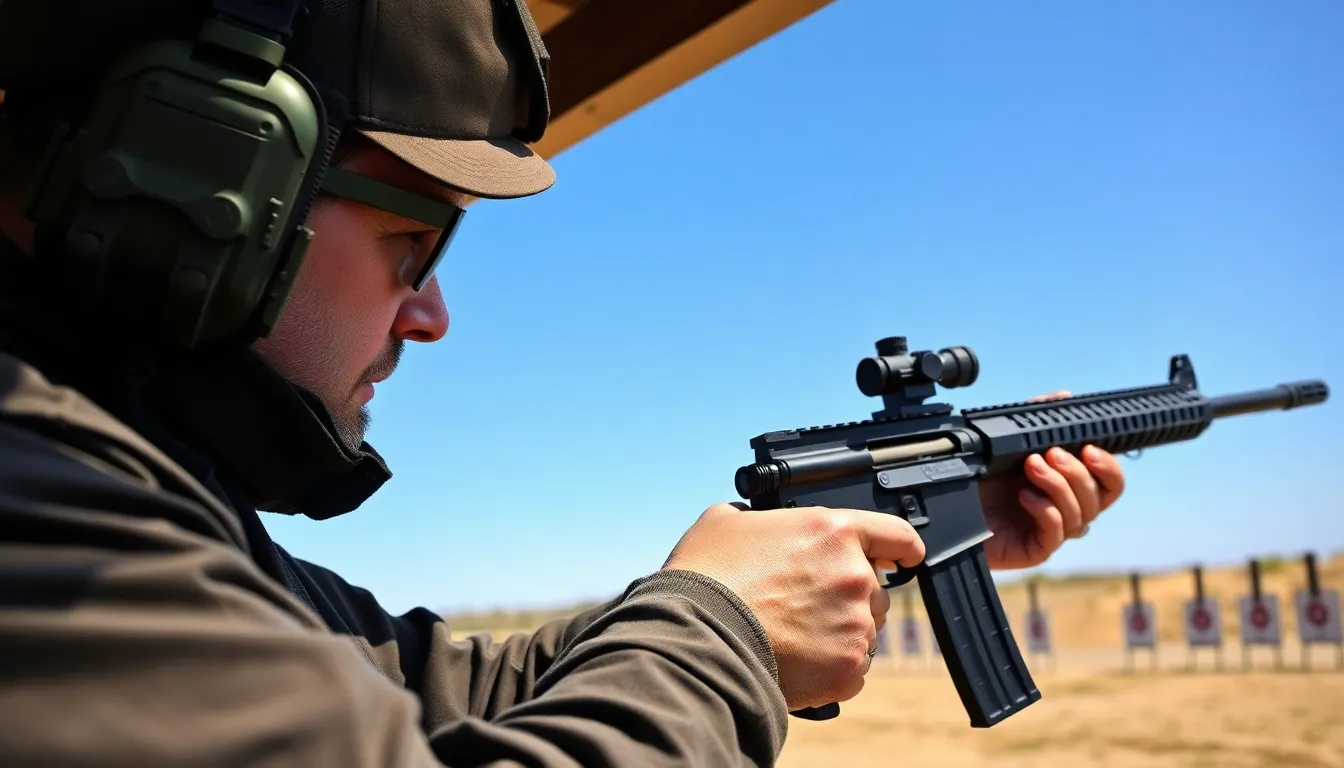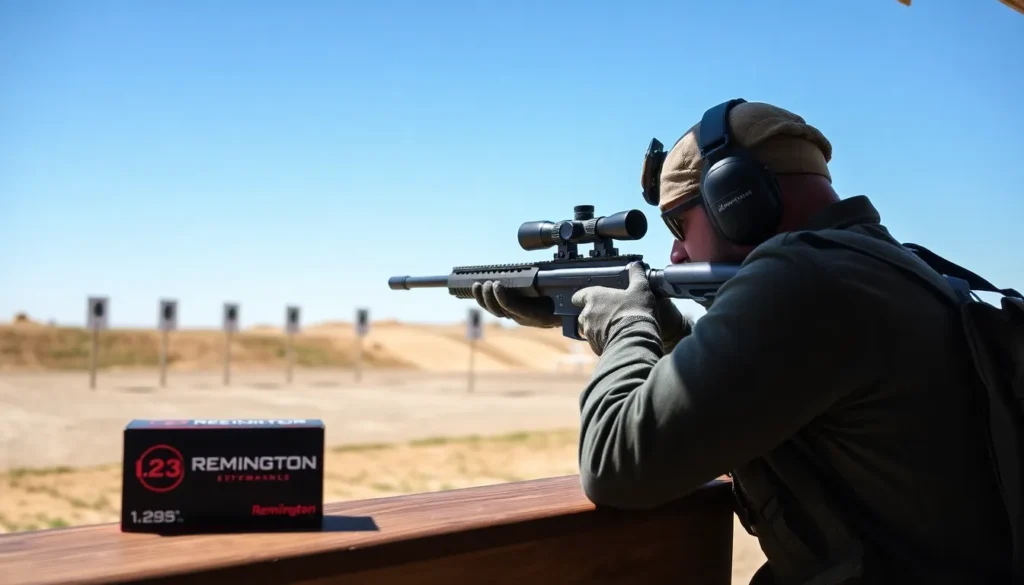Table of Contents
ToggleWhen it comes to firearms, few calibers stir up as much excitement as the .223 Remington. Known for its versatility and precision, this round has become a favorite among hunters, sport shooters, and tactical enthusiasts alike. But what’s all the fuss about? Buckle up, because diving into the world of .223 fps is like stepping into a high-speed chase—thrilling and packed with surprises.
Understanding 223 FPS
.223 fps refers to the feet per second velocity of .223 Remington rounds when fired. This velocity significantly impacts performance, accuracy, and terminal ballistics. Typically, .223 Remington rounds achieve speeds between 2,800 and 3,200 fps depending on the bullet weight and powder charge. For example, a 55-grain projectile might reach around 3,200 fps, while a heavier 77-grain round may travel closer to 2,800 fps.
Velocity influences how quickly the projectile reaches its target and affects the bullet’s trajectory over distances. Faster bullets tend to maintain flatter trajectories, improving long-range accuracy. At distances over 200 yards, a bullet traveling at high velocities mitigates the effects of wind, gravity, and bullet drop.
Several factors contribute to the fps of .223 ammunition. Barrel length, ammunition type, and environmental conditions play vital roles. Longer barrels often yield greater velocities since they allow the powder to burn completely before exiting the muzzle. Moreover, match-grade ammunition usually offers higher velocities due to tighter tolerances and specialized designs.
Understanding .223 fps is crucial for anyone engaging in long-range shooting or competitive sports. A knowledgeable shooter will consider how different velocities interact with factors like bullet drop and wind drift. Therefore, selecting the appropriate .223 round based on desired fps can enhance overall accuracy and effectiveness during use.
Importance of 223 FPS in Shooting

The fps of .223 Remington rounds plays a crucial role in shooting scenarios. A higher fps improves accuracy and overall performance.
Accuracy and Performance
Precision remains vital for effective shooting, and .223 fps directly influences this factor. Faster projectiles maintain a flatter trajectory, reducing bullet drop over distance. Shooters benefit from enhanced target acquisition due to the swift speed of these rounds. Consistent velocities contribute to repeatable accuracy, especially in competitive settings. For example, a 55-grain round reaching 3,200 fps allows for tighter groupings at long ranges, making it a preferred choice among sharpshooters. Understanding these dynamics can help shooters select appropriate ammo for specific applications.
Impact on Ballistics
Ballistics involve how a bullet behaves in flight, with .223 fps significantly affecting terminal performance. Higher velocities result in increased energy transfer upon impact, leading to more effective wound channels. This aspect becomes especially critical in hunting situations, where terminal ballistics influence ethical shot placement. Additionally, faster rounds reduce the impact of wind drift, providing improved accuracy in challenging conditions. It’s important to consider barrel length and ammo type, as these factors also play a role in achieving desired velocities. Recognizing the relationship between fps and ballistics helps shooters make informed choices for varying scenarios.
Factors Affecting 223 FPS
Multiple factors influence the fps of .223 ammunition, including barrel length, ammunition type, and environmental conditions. Each aspect plays a crucial role in determining the velocity achieved when firing.
Barrel Length
Barrel length significantly impacts the fps of .223 rounds. Longer barrels enable more complete combustion of the powder, resulting in higher velocities. Typically, a 20-inch barrel can produce speeds around 3,200 fps using lighter 55-grain projectiles. In contrast, a 16-inch barrel may yield an fps closer to 2,900-3,000. Certain shooters prefer longer barrels for enhanced accuracy due to the increased velocity and improved stability, while others might opt for shorter ones for maneuverability in tactical scenarios.
Ammo Type
Ammunition type directly affects the fps achieved with .223 rounds. Match-grade ammo typically features tighter tolerances and optimized powder charges, allowing for velocities above 3,000 fps. For example, using a 69-grain match bullet can result in higher fps compared to standard 55-grain plinking rounds. Specialty loads designed for specific purposes, like varmint hunting or training, can also provide distinct velocity characteristics. Choosing the right ammo type enhances overall performance in various shooting situations.
Environmental Conditions
Environmental conditions have a substantial effect on .223 fps. Factors like temperature, humidity, and altitude can alter how effectively the powder burns and the resulting velocity. Warmer temperatures often lead to higher fps as gas expands more rapidly, whereas cold conditions may reduce velocity. Additionally, altitude impacts air density, affecting aerodynamic performance and bullet drop. Understanding these variables enables shooters to make more effective adjustments, ensuring greater accuracy in diverse shooting environments.
Common Uses of 223 FPS
The .223 fps finds relevance across various shooting disciplines. Its velocity affects performance and accuracy in several key areas.
Target Shooting
Target shooting often utilizes .223 fps for its precision and manageable recoil. Shooters frequently choose this caliber for practice, as its speed provides flatter trajectories, enhancing accuracy at broader ranges. A typical 55-grain round traveling at 3,200 fps ensures tight groupings, making it ideal for enthusiasts looking to improve skills. Additionally, the consistent velocities allow shooters to track their progress effectively, benefitting from precise feedback on each shot. Increased fps helps mitigate bullet drop, leading to a more enjoyable shooting experience.
Hunting
Hunting applications benefit significantly from the velocity of .223 fps. The speed of the round plays a critical role in energy transfer upon impact, crucial for creating effective wound channels. A 77-grain round at about 2,800 fps offers enough power for small to medium game, making it an excellent choice for hunters. Furthermore, the flatter trajectory contributes to hunting accuracy over varying distances. Wind drift is another consideration; higher fps rounds experience less deviation, aiding hunters in challenging environments. Understanding .223 fps allows hunters to select the right ammunition for their needs.
Competitive Shooting
Competitive shooting heavily relies on the advantages of .223 fps for maximum performance. Participants often use this caliber in matches due to its velocity and accuracy. The benefits become especially apparent when considering scenarios that require rapid-fire capabilities. A consistent 3,200 fps helps ensure tight groupings, while reduced bullet drop enhances long-range performance. Shooters frequently choose match-grade ammunition to achieve the necessary velocities and precision. Utilizing .223 fps, competitors can adapt to various shooting conditions and maintain an edge in competitions.
Understanding .223 fps is vital for anyone involved in shooting sports or hunting. The velocity of these rounds directly influences accuracy and performance. With speeds ranging from 2,800 to 3,200 fps depending on various factors, shooters can make informed decisions about their ammunition choices.
Higher velocities not only enhance target acquisition but also improve energy transfer upon impact. This knowledge allows enthusiasts to adapt their strategies for different shooting scenarios, whether in competitions or while hunting. Ultimately, mastering the intricacies of .223 fps can lead to a more successful and enjoyable shooting experience.







